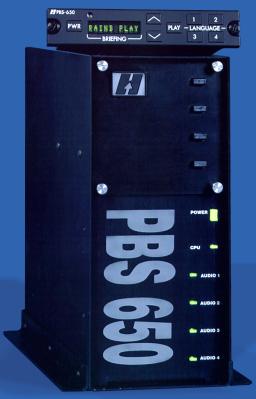
|

This was an expanded version of Heads Up's line of passenger-briefing products (which already included the HUCAB and PBS-250/400 products). Development, in 1995, was prompted by the needs of a company called Scenic Airlines, which flies tour-planes over the Grand Canyon. (See www.scenic.com.)While a passenger-briefing system for normal flight operations requires just a couple of minutes of audio for each language used, a tour operation requires considerably more -- say, 20 minutes for each language and each possible tour route. This means that while a PBS-400 passenger-briefing system might require 10M bytes of audio, the PBS-650 would require hundreds of megabytes of audio. Also, while it may be acceptable for a safety briefing to be played back in successive languages (for example, English first, then French, then Spanish, etc.), a tour operation requires simultaneous playback in all languages used. This means that rather than one simultaneous playback channel, the PBS-650 would require 4 simultaneous playback channels. And there were other flourishes as well.
Thus, while the firmware could maintain a large overlap with the earlier PBS-400 software, it also required major changes to deal with these (and other) new features.
Here are some points of interest about the project:
The appeal of the PBS-650 product is limited primarily to tour-operations. Thus, it has been sold only to its original customer, Scenic Airlines, and a few other tour-plane or tour-bus operations. The decision to develop the product may have been ill-advised. The product itself is solid, except for the fragile nature of the hard disks included in it. (I argued against their use, and hence take no responsibility for it.) Today, of course, we can simply pull out the PCMCIA hard-disk cards in the units and replace them with fully-reliable PCMCIA ATA flash-memory cards, albeit at a somewhat higher cost.This was the first project in which I provided the firmware but very little of the hardware. While I did dictate the hardware architecture to a large extent, I did almost none of the actual circuitry. This required a much higher reliance and a greater degree of cooperation with other designers than I was used to. The PBS-650 was field-programmable by replacement of hard-disk drives that were accessible from a hatch on the front of the unit. For convenience in manufacturing, I therefore replaced the proprietary file-system I had invented for my prior designs with an MS-DOS compatible file-system. In other words, we reprogrammed the PBS-650 hard disks, which were in the form of PCMCIA Type III cards, by placing them into a PC-compatible computer and using normal MS-DOS file-copy operations. The unit contained a main CPU circuit board and 4 of my pre-existing IVA circuit boards, thus it was a 5-CPU design. The 4 IVA circuit boards had firmware that differed from their pre-existing firmware. Thus, I had two write two sets of firmware for the 5 CPUs. Distribution of the data required in real-time was a challenge. Hard disks, by their nature, are not really good media for extracting real-time data at a constant rate. To this complication, add the difficulty of fetching this data from 4 separate locations on the hard disks (there were up to 4 hard disks in any given unit), and sending it to 4 separate audio-playback devices.